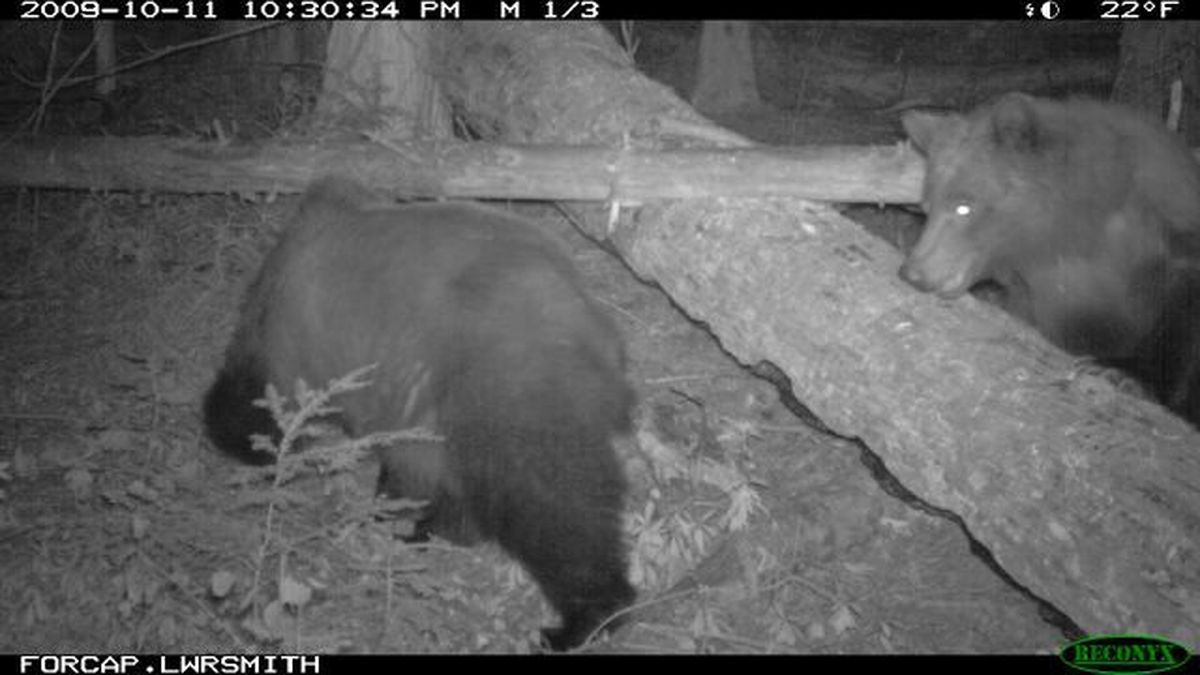See Bear Run
Bonners Ferry timber company looking out for bears

It’s a scene that takes some getting used to for conservationists: on a hillside, a mechanized tractor methodically cuts every tree of a certain size, the first part of a process that ends in paper and pulp and furniture.
Just downhill, I’m careful to not get in anyone’s way as a flurry of activity unfolds—the cutting, sizing and piling of logs. A Paul Bunyan-sized man stands on top of a pile, deftly chaining the next load, destined for a North Idaho sawmill.
The forest in front of us—and similar forests around the Inland Northwest—make up an important part of a conservation vision for North Idaho.
And what will change if that vision becomes reality? No much at all. Timber harvest, clearcuts and all.
Organizations like The Nature Conservancy recognize that sustainable forest harvest, unlike sprawling home developments, is compatible with a variety of wildlife species, including large mammals.
Grizzly bears don’t share the human sense of aesthetics. From a bear’s standpoint, a managed forest means huckleberry patches and open space. A development means houses, roads and yapping dogs—all proven to stop grizzlies in their tracks.
Consider the Kootenai River Valley, north of Bonners Ferry, Idaho, along the Canadian border. You could think of this scenic valley as the habitat equivalent of an Oreo cookie: Forested mountains on one side. Forested mountains on the other. A valley covered in wetlands and farms in between.
If you hiked to a mountain peak in the Selkirks (or better yet, flew over the area in a small plane), you’d first notice forests stretching out in every direction. You’d see no county or state lines, no boundaries, just expansive forests.
That’s where the wild things are.
As you looked closer, you’d undoubtedly notice the valleys, with farms, ranches and small forest patches. In places, rows of trees finger well into the valley.
That’s where the wild things cross, from one mountain range to the next.
When a grizzly bear moves from one large forest to another, here’s what happens: First, it follows those rows of trees out of the forest, using windbreaks and the tiniest forest patches for cover.
When the bear runs out of hiding spaces, it waits patiently for night. Radio-collared bears consistently reveal this behavior.
When darkness descends, the bear runs. Fast.
It runs as if its life depends on it, because it does. The bear doesn’t stop until it reaches the other side of the valley.
If the bear has more tracts of forest, it can feel more secure. It doesn’t have to run in a wild panic. Its life is not at risk. As such, large managed forests become an important component to grizzlies’ continued survival in North Idaho.
One such place is forest area known as Boundary Creek, a property owned by Forest Capital Partners, a private forest management company.
The Nature Conservancy recently announced a 647-acre conservation easement—a legal agreement that prohibits development—on the property. The project is illustrative of how both wildlife and rural jobs can be protected.
Forest Capital Partners will continue to actively manage the forest, with conservation practices in place to benefit the grizzlies and other wildlife. The company will not harvest timber during months when grizzlies use the area (something it had implemented before the easement). The easement will also create and maintain forest buffers along the stream and roads to improve fish and wildlife habitat.
A grant from the Doris Duke Charitable Foundation to support protection for ecologically important lands helped make this project possible. The easement acquisition also was funded by the U.S. Fish and Wildlife Service’s Endangered Species Recovery Land Acquisition program to the Idaho Department of Fish and Game. This is the first time this program has supported a grizzly bear habitat project.
And as for those bears? Trail cameras already reveal an active grizzly bear presence on the property. In short: The bears feel safe there. They move through the area, from one national forest to the other.
Aside from those cameras, the bears aren’t often seen. They’ve learned that remaining secretive is the key to survival. The Conservancy’s Inland Northwest land steward, Justin Petty, lived, worked and walked this area for four years without seeing a bear.
But having walked that area, I can assure you this: You never really forget they’re around. Suddenly a hike feels wilder, a forest feels more complete, to know the top predator still roams—something that great conservationists from Aldo Leopold to Ed Abbey all realized.
There aren’t many places left where you can still feel that presence, where the grizzly still roams. And to keep those bears means putting aside preconceived notions. It may mean rethinking our vision for forests. It may mean learning to love clearcuts.
Because, in North Idaho, the fate of grizzlies is tied to the fate of working forests. Those private lands hold the key to an entire ecosystem, and to the wild heart of the Inland Northwest.
Matt Miller is director of communications for The Nature Conservancy in Idaho. Read more at Idaho Nature Notes (www.idahonaturenotes.blogspot.com) and Cool Green Science (blog.nature.org/author/mmiller).